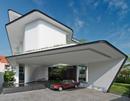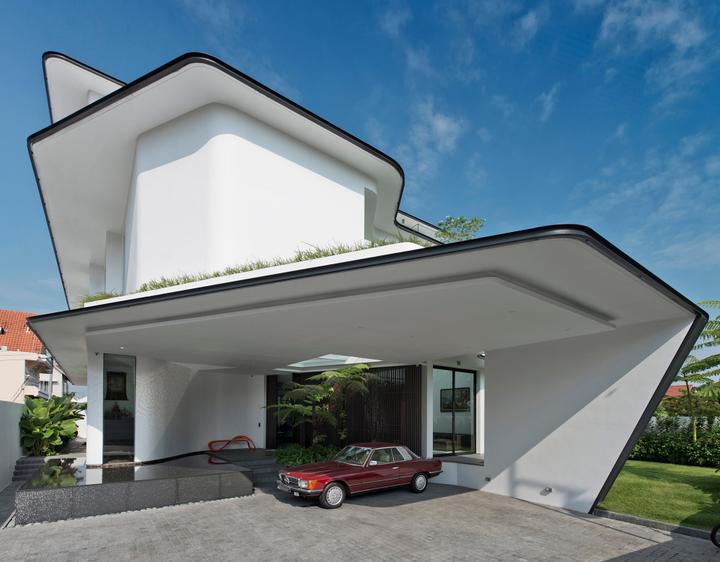1 / 14














Project Details
As firm believer of Fengshui, the design proposal and the site needs to be one that has a Northeast frontage. These requirements even pre-determined the colour palette, spatial organisation and general layout.
With these pre-requisites the challenge was to come up with a design strategy that melds seamlessly into the requirements that are guided by Fengshui. This design strategy must also tackle the site context effectively - given that the site is located within a rather dense landed residential area with no good views out.
Design Strategy
The lack of good vistas around the site propelled the design for an inward looking house. This is strategized by introducing (1) a central courtyard and (2) layered landscaping throughout the peripheral of the house.
The central courtyard effectively anchors the spatial arrangement and provide a sense of connectivity throughout the common spaces. Just like the airwells in traditional shop houses, it provides an outlet for warm air to escape while improving cross-ventilation throughout the house. This airwell also allows much light to come through, diffusing daylight into the internal spaces around it.
Hanging Garden
But perhaps the main feature of this courtyard is the ‘hanging gardens’. The initial proposal for trees to be planted in the ground within this courtyard was disallowed due to fengshui. Hence the alternative is sought and a vertical hanging garden is conceived. This vertical garden is basically a series of stacked up planter boxes, arranged in a staggered fashion to maximize sunlight exposure . A main frame holds these planters and guides irrigation pipes into each planter boxes. To ease maintenance and change of plants, a concealed catladder is also integrated within this main frame.
Layered landscaping
Around the house, pockets of greenery are introduced to create filtered vistas and layered landscaping. This at the same time increases porosity and create depth. Roof gardens at the attic are also strategically placed so that these stagger with the lower gardens to form overlapping terraces of greenery.
With these two strategies in place, one would be able to feel that he is surrounded by gardens at every level.
Façade Articulation
The fluid lines of the exterior take bearing from the slanted orientation of the entrance door and gate. This slant is again due to Fengshui requirement. Ledges are articulated like continuous fluid ‘ribbons’ that gently wrap around the building and give the house its character. This fluid lines attempt to soften massing that could otherwise be too overwhelming due to the regulatory need to increase platform level/ first floor level. Moreover the attic floor is tucked towards the back to further reduce the impact of the massing.
Spatial Organization
Rooms and spaces are ordered around the central courtyard. The ground floor assumes the entertainment floor with a pseudo open-plan layout. Each space can spill out to the other with the courtyard allowing smooth overlapping of spatial needs. Common bedrooms and Junior Master bedroom are located on the second floor while the Master Suite takes on the whole attic floor.
The whole house uses LED light fittings which further reduce heat build-up internally while lowering power.As firm believer of Fengshui, the design proposal and the site needs to be one that has a Northeast frontage. These requirements even pre-determined the colour palette, spatial organisation and general layout.
With these pre-requisites the challenge was to come up with a design strategy that melds seamlessly into the requirements that are guided by Fengshui. This design strategy must also tackle the site context effectively - given that the site is located within a rather dense landed residential area with no good views out.
Design Strategy
The lack of good vistas around the site propelled the design for an inward looking house. This is strategized by introducing (1) a central courtyard and (2) layered landscaping throughout the peripheral of the house.
The central courtyard effectively anchors the spatial arrangement and provide a sense of connectivity throughout the common spaces. Just like the airwells in traditional shop houses, it provides an outlet for warm air to escape while improving cross-ventilation throughout the house. This airwell also allows much light to come through, diffusing daylight into the internal spaces around it.
Hanging Garden
But perhaps the main feature of this courtyard is the ‘hanging gardens’. The initial proposal for trees to be planted in the ground within this courtyard was disallowed due to fengshui. Hence the alternative is sought and a vertical hanging garden is conceived. This vertical garden is basically a series of stacked up planter boxes, arranged in a staggered fashion to maximize sunlight exposure . A main frame holds these planters and guides irrigation pipes into each planter boxes. To ease maintenance and change of plants, a concealed catladder is also integrated within this main frame.
Layered landscaping
Around the house, pockets of greenery are introduced to create filtered vistas and layered landscaping. This at the same time increases porosity and create depth. Roof gardens at the attic are also strategically placed so that these stagger with the lower gardens to form overlapping terraces of greenery.
With these two strategies in place, one would be able to feel that he is surrounded by gardens at every level.
Façade Articulation
The fluid lines of the exterior take bearing from the slanted orientation of the entrance door and gate. This slant is again due to Fengshui requirement. Ledges are articulated like continuous fluid ‘ribbons’ that gently wrap around the building and give the house its character. This fluid lines attempt to soften massing that could otherwise be too overwhelming due to the regulatory need to increase platform level/ first floor level. Moreover the attic floor is tucked towards the back to further reduce the impact of the massing.
Spatial Organization
Rooms and spaces are ordered around the central courtyard. The ground floor assumes the entertainment floor with a pseudo open-plan layout. Each space can spill out to the other with the courtyard allowing smooth overlapping of spatial needs. Common bedrooms and Junior Master bedroom are located on the second floor while the Master Suite takes on the whole attic floor.
The whole house uses LED light fittings which further reduce heat build-up internally while lowering power.Read MoreHide
Area Size
557m²
Year of Completion
2013
Interior Style
Modern
Works included
Carpentry
Hacking
Tiling
False Ceiling
Aircon
Electrical Rewiring
Plumbing
Feature Wall
Painting















